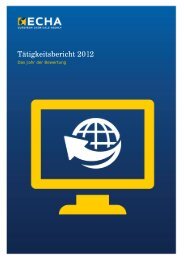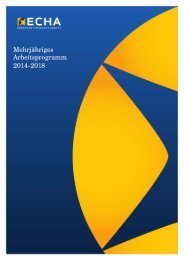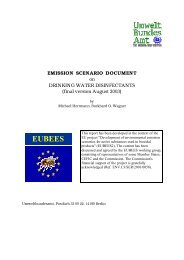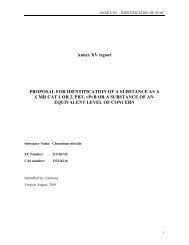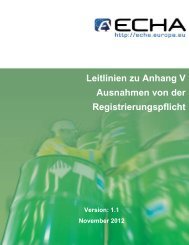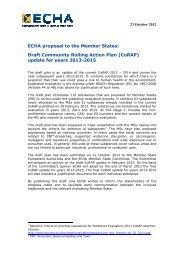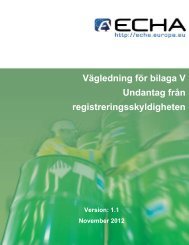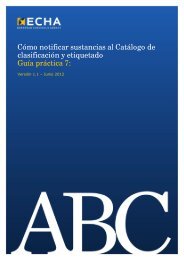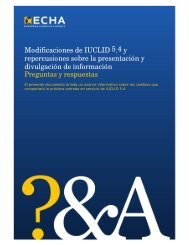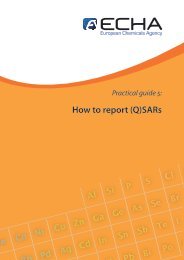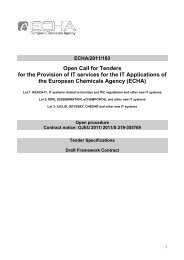Strategy For Limiting Risks Human Health Draft of ... - ECHA - Europa
Strategy For Limiting Risks Human Health Draft of ... - ECHA - Europa
Strategy For Limiting Risks Human Health Draft of ... - ECHA - Europa
You also want an ePaper? Increase the reach of your titles
YUMPU automatically turns print PDFs into web optimized ePapers that Google loves.
and the analog sodium fluoride (NTP studies). Due to negative and equivocal test results with<br />
synthetic cryolite and sodium fluoride there is no concern for carcinogenicity. The RAR on<br />
HF concluded that fluoride is not a carcinogenic substance.Therefore the handling <strong>of</strong> cryolite<br />
regarding carcinogenicity is safe for consumers.<br />
Conclusion (ii) There is at present no need for further information and/or testing and<br />
for risk reduction measures beyond those which are being applied<br />
already.<br />
Toxicity for reproduction<br />
Effects on fertility<br />
There is no indication for fertility risks caused by cryolite, therefore there is no concern for<br />
consumers. A quantitative risk characterisation is not necessary.<br />
Conclusion (ii) There is at present no need for further information and/or testing and<br />
for risk reduction measures beyond those which are being applied<br />
already.<br />
Developmental toxicity<br />
Cryolite was investigated for prenatal developmental toxicity in rats, mice and rabbits with<br />
the oral route <strong>of</strong> administration. During the two-generation study with rats, administering 0,<br />
14, 42, 128 mg cryolite/kg bw/day in the diet, growth retardation in postnatal development<br />
was observed. Because this effect occured without any significant sign for systemic toxicity it<br />
is considered indicative for a specific toxic potential <strong>of</strong> cryolite adverse to postnatal<br />
development. The respective NOAEL in the diet study was 42 mg cryolite/kg bw/day. This<br />
value is taken for risk characterisation and used for MOS calculation.<br />
<strong>For</strong> the decision on the appropriateness <strong>of</strong> MOS, the following aspects have been considered<br />
and taken into account.<br />
-overall confidence in the database:<br />
The data taken into account for performing the risk characterisation have been evaluated with<br />
regard to their reliability, relevance and completeness according to section 3.2 <strong>of</strong> the TGD.<br />
Most <strong>of</strong> the animal data are citations from the secondary literature. The orginal data are not<br />
available. Due to the developmental effects described the proposal to classify cryolite as Repr.<br />
Cat 3, R63 is justified.<br />
-uncertainty arising from the variability in the experimental data:<br />
There are no reasons to assume a special extent <strong>of</strong> uncertainty<br />
-intra- and interspecies variation:<br />
Available data do not allow a conclusion on the intraspecies or interspecies variability <strong>of</strong> the<br />
toxicokinetic or toxicodynamic characteristics <strong>of</strong> cryolite under consideration.<br />
33



